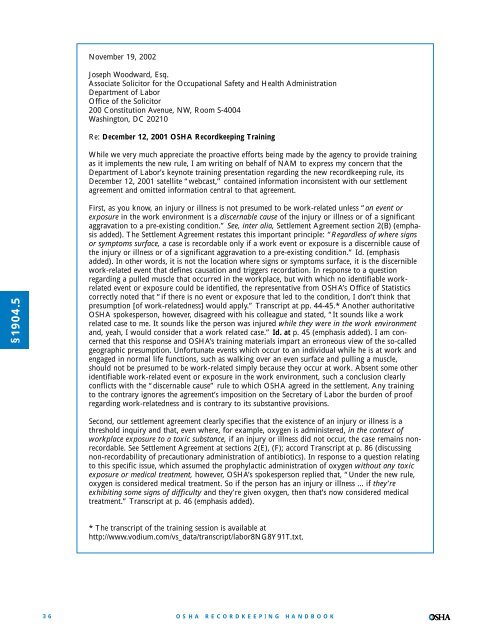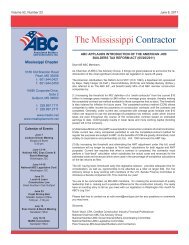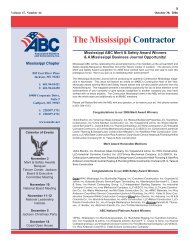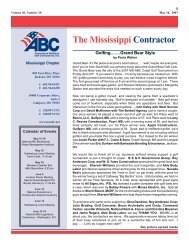November 19, 2002Joseph Woodward, Esq.Associate Solicitor for the Occupational Safety and Health AdministrationDepartment of LaborOffice of the Solicitor200 Constitution Avenue, NW, Room S-4004Washington, DC 20210Re: December 12, 2001 <strong>OSHA</strong> <strong>Recordkeeping</strong> TrainingWhile we very much appreciate the proactive efforts being made by the agency to provide trainingas it implements the new rule, I am writing on behalf of NAM to express my concern that theDepartment of Labor’s keynote training presentation regarding the new recordkeeping rule, itsDecember 12, 2001 satellite “webcast,” contained information inconsistent with our settlementagreement and omitted information central to that agreement.§1904.5First, as you know, an injury or illness is not presumed to be work-related unless “an event orexposure in the work environment is a discernable cause of the injury or illness or of a significantaggravation to a pre-existing condition.” See, inter alia, Settlement Agreement section 2(B) (emphasisadded). The Settlement Agreement restates this important principle: “Regardless of where signsor symptoms surface, a case is recordable only if a work event or exposure is a discernible cause ofthe injury or illness or of a significant aggravation to a pre-existing condition.” Id. (emphasisadded). In other words, it is not the location where signs or symptoms surface, it is the discerniblework-related event that defines causation and triggers recordation. In response to a questionregarding a pulled muscle that occurred in the workplace, but with which no identifiable workrelatedevent or exposure could be identified, the representative from <strong>OSHA</strong>’s Office of Statisticscorrectly noted that “if there is no event or exposure that led to the condition, I don’t think thatpresumption [of work-relatedness] would apply.” Transcript at pp. 44-45.* Another authoritative<strong>OSHA</strong> spokesperson, however, disagreed with his colleague and stated, “It sounds like a workrelated case to me. It sounds like the person was injured while they were in the work environmentand, yeah, I would consider that a work related case.” Id. at p. 45 (emphasis added). I am concernedthat this response and <strong>OSHA</strong>’s training materials impart an erroneous view of the so-calledgeographic presumption. Unfortunate events which occur to an individual while he is at work andengaged in normal life functions, such as walking over an even surface and pulling a muscle,should not be presumed to be work-related simply because they occur at work. Absent some otheridentifiable work-related event or exposure in the work environment, such a conclusion clearlyconflicts with the “discernable cause” rule to which <strong>OSHA</strong> agreed in the settlement. Any trainingto the contrary ignores the agreement’s imposition on the Secretary of Labor the burden of proofregarding work-relatedness and is contrary to its substantive provisions.Second, our settlement agreement clearly specifies that the existence of an injury or illness is athreshold inquiry and that, even where, for example, oxygen is administered, in the context ofworkplace exposure to a toxic substance, if an injury or illness did not occur, the case remains nonrecordable.See Settlement Agreement at sections 2(E), (F); accord Transcript at p. 86 (discussingnon-recordability of precautionary administration of antibiotics). In response to a question relatingto this specific issue, which assumed the prophylactic administration of oxygen without any toxicexposure or medical treatment, however, <strong>OSHA</strong>’s spokesperson replied that, “Under the new rule,oxygen is considered medical treatment. So if the person has an injury or illness ... if they’reexhibiting some signs of difficulty and they’re given oxygen, then that’s now considered medicaltreatment.” Transcript at p. 46 (emphasis added).* The transcript of the training session is available athttp://www.vodium.com/vs_data/transcript/labor8NG8Y91T.txt.36<strong>OSHA</strong> RECORDKEEPINGHANDBOOK
The problem with the response is two-fold: (1) It ignores the question’s assumption that no injuryor illness requiring medical treatment was present and (2) it equates “some sign of difficulty” withan illness or injury. As you know, the settlement expressly states that an employee must exhibitsymptoms of an injury or illness in order for the administration of oxygen to constitute recordablemedical treatment. Settlement Agreement at section 2(F). “Some signs of difficulty,” particularly inthe absence of any medical treatment, would not necessarily constitute “symptoms of an injury orillness.” For example; a professional football player who leaves the field winded and who takes abreath of oxygen might be experiencing “some signs of difficulty” but might not be suffering from“symptoms of an injury or illness.” Thus, the answer to the question as posed should have clearlybeen that the administration of oxygen, absent other medical treatment or related injury or illness,is not recordable. Without further clarification, I am concerned that the <strong>OSHA</strong> reply might haveled participants to conclude that almost all administrations of oxygen are presumptively recordablecases.Third, I am generally concerned that <strong>OSHA</strong>’s training materials (including the satellite presentationand the materials contained on <strong>OSHA</strong>’s web site) completely omit any reference to a number of significantinterpretations in the settlement agreement. For example, neither the satellite training northe Power Point “Comprehensive Presentation” on <strong>OSHA</strong>’s web site address the preventive transferissue, an important clarification contained in our settlement agreement. See Settlement Agreementat section 2(C). I respectfully suggest that this issue should be discussed in order to provide fullcontext for any understanding of restricted work. The training materials also fail to discuss the“discernable cause” concept, and the “more likely than not” analysis employed when causation isunclear. Instead, the materials leave the regulated community with the misimpression that unless“symptoms arising in [the] work environment are solely due to [a] non-work-related event or exposure,”they are otherwise recordable. See Comprehensive Presentation at Slide 16 (emphasisadded); see also id. at Slide 13 (restating geographic presumption without clarification from settlementagreement). Appropriate clarification would have resolved the confusion attendant to the firstissue described above. Additionally, the discussion of hearing loss causation at pages 63 to 64 ofthe satellite training transcript would have been an appropriate point at which to apply these principles.Finally, we believe that future training should identify the compliance directive, which incorporatesthe settlement agreement, as an important source of clarification for recordkeeping questions. Forexample, at pages 77, 78, 90 and 91, the trainers identified a number of sources of information,but did not mention the compliance directive.§1904.5Our principal concern is that if these issues are not presented clearly during <strong>OSHA</strong>’s primary trainingsessions, they will not be executed properly by <strong>OSHA</strong>’s field staff. <strong>OSHA</strong>’s compliance officerswill provide advice and issue citations based upon an erroneous understanding of these criticalissues, and theprinciples embodied in the compliance directive will not be consistently and correctlyapplied throughout the nation.Thank you for your consideration of my thoughts. I appreciate the opportunity to engage in a constructivedialogue as employees, employers and <strong>OSHA</strong> work together to implement the new rule.Sincerely,Baruch A. Fellnercc: The Honorable John HenshawThe Honorable Christopher SpearMr. Tevi Troy<strong>OSHA</strong> RECORDKEEPINGHANDBOOK37
- Page 1 and 2: www.osha.govOSHARecordkeepingHandbo
- Page 3 and 4: OSHARecordkeeping HandbookThe Regul
- Page 5 and 6: ContentsRecordkeeping HandbookRoadm
- Page 7 and 8: Section 1904.40Providing records to
- Page 9 and 10: Section 1904.0Purpose(66 FR 6122, J
- Page 11 and 12: Section 1904.1Partial exemption for
- Page 13 and 14: Section 1904.2Partial exemption for
- Page 15 and 16: employees, to OSHA within 8 hours (
- Page 17 and 18: Partial Exemptions for Employers Un
- Page 19 and 20: Section 1904.4Recording criteria(66
- Page 21 and 22: Section 1904.5Determination of work
- Page 23 and 24: (b)(7) How do I decide if a case is
- Page 25 and 26: well, including providing informati
- Page 27 and 28: This exception, which responds to i
- Page 29 and 30: or she is in the work environment a
- Page 31 and 32: have occurred but for the occupatio
- Page 33 and 34: considered work-related. If an empl
- Page 35 and 36: Question 5-12. Is work-related stre
- Page 37 and 38: • The doctor described the illnes
- Page 39 and 40: Scenario 7:• A site hired numerou
- Page 41 and 42: Letter of interpretation related to
- Page 43: These principles should be applied
- Page 47 and 48: Section 1904.6Determination of new
- Page 49 and 50: the Guidelines stated that “the a
- Page 51 and 52: estricted work. If the case is a pr
- Page 53 and 54: • The doctor also prescribed the
- Page 55 and 56: • The employees were under the di
- Page 57 and 58: Section 1904.7General recording cri
- Page 59 and 60: (iii) Do I have to record restricte
- Page 61 and 62: of the length of time the employee
- Page 63 and 64: then result in days away from work
- Page 65 and 66: A partial day of work is recorded a
- Page 67 and 68: In all other respects, the final ru
- Page 69 and 70: ments. The Agency believes that the
- Page 71 and 72: e recorded because it will require
- Page 73 and 74: However, episodes of fainting from
- Page 75 and 76: care professional, he or she may al
- Page 77 and 78: “Other simple means” of removin
- Page 79 and 80: For purposes of OSHA recordkeeping
- Page 81 and 82: • When answering the doctor’s q
- Page 83 and 84: Response: In the recordkeeping regu
- Page 85 and 86: Letter of interpretation related to
- Page 87 and 88: Section 1904.8Recording criteria fo
- Page 89 and 90: caused by contaminated needles and
- Page 91 and 92: Section 1904.9Recording criteria fo
- Page 93 and 94: Section 1904.10Recording criteria f
- Page 95 and 96:
hearing loss case that is not relat
- Page 97 and 98:
average of 10 decibels or more at 2
- Page 99 and 100:
argued that because the function of
- Page 101 and 102:
occurs, and where hearing loss can
- Page 103 and 104:
cases in their workplace via analys
- Page 105 and 106:
March 4, 2004Mr. Carl O. Sall, CIHD
- Page 107 and 108:
When the professional evaluating th
- Page 109 and 110:
(2) May I line-out or erase a recor
- Page 111 and 112:
Section 1904.12Recording criteria f
- Page 113 and 114:
These new statistics would add only
- Page 115 and 116:
Sections 1904.13 - 1904.28 Reserved
- Page 117 and 118:
two lines of the OSHA 300 Log to de
- Page 119 and 120:
which replace the OSHA 200 and 101
- Page 121 and 122:
different types of occupational ill
- Page 123 and 124:
OSHA 301 form. These data are usefu
- Page 125 and 126:
LETTERS OF INTERPRETATION: Section
- Page 127 and 128:
Question 2: Under 29 CFR Section 19
- Page 129 and 130:
and has adopted language in the fin
- Page 131 and 132:
Section 1904.31Covered employees(66
- Page 133 and 134:
label assigned to a worker is immat
- Page 135 and 136:
These workers should be evaluated j
- Page 137 and 138:
Response: A case is work-related if
- Page 139 and 140:
Response: Section 1904.31 states th
- Page 141 and 142:
Thank you for your interest in occu
- Page 143 and 144:
year covered by the summary. The su
- Page 145 and 146:
2. Number of employees and hours wo
- Page 147 and 148:
LETTERS OF INTERPRETATION: Section
- Page 149 and 150:
Section 1904.33Retention and updati
- Page 151 and 152:
June 23, 2003Mr. Edwin G. Foulke, J
- Page 153 and 154:
Section 1904.34Change in business o
- Page 155 and 156:
PREAMBLE DISCUSSION: Section 1904.3
- Page 157 and 158:
Incident Report (Forms 300 and 301,
- Page 159 and 160:
workers’ compensation claim. See
- Page 161 and 162:
LETTERS OF INTERPRETATION: Section
- Page 163 and 164:
Letter of interpretation related to
- Page 165 and 166:
Question 3: Using the facts in Ques
- Page 167 and 168:
Section 1904.37State recordkeeping
- Page 169 and 170:
tion, require employers to report f
- Page 171 and 172:
(5) If I receive a variance, may th
- Page 173 and 174:
Section 1904.39Reporting fatalities
- Page 175 and 176:
gation. Therefore, the final rule d
- Page 177 and 178:
Section 1904.40Providing records to
- Page 179 and 180:
ness. The government inspector may
- Page 181 and 182:
Response: The controlling employer
- Page 183 and 184:
FREQUENTLY ASKED QUESTIONS: Section
- Page 185 and 186:
OSHA and the BLS have worked togeth
- Page 187 and 188:
provide copies of the retained reco
- Page 189 and 190:
FREQUENTLY ASKED QUESTIONS: Section
- Page 191 and 192:
Section 1904.46Definitions(66 FR 61
- Page 193 and 194:
of business information. For exampl
- Page 195 and 196:
inconvenience associated with keepi
- Page 197 and 198:
skin disease, respiratory disorder,
- Page 199 and 200:
Question 2: Under 29 CFR Section 19
- Page 201:
www.osha.gov







